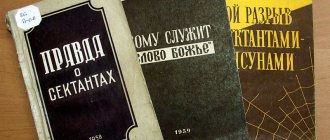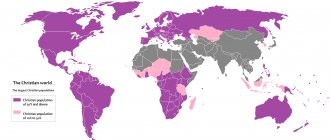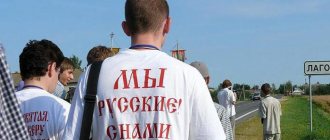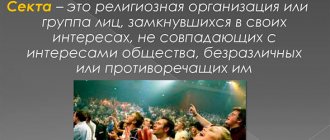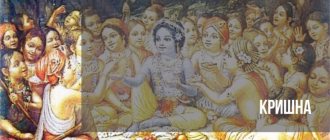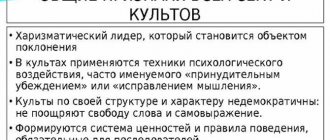Among the variety of religious movements, which are based on a distorted form of Christian teaching, a special place belongs to the sect of eunuchs - people who deliberately mutilate their own flesh in the hope of thus overcoming its natural, and in their opinion, sinful urges. Despite the extremely harsh condemnation of this phenomenon by the Russian Orthodox Church, in certain historical periods it was widespread. Let us dwell in more detail on who the eunuchs are and what is unique about their worldview.
You may be interested in: Apex is... The meaning of the word “apex”
Self-proclaimed messiah
The founder and ideologist of the Russian skopchestvo is considered to be the runaway serf peasant of the Oryol province Kondraty Ivanovich Selivanov (1740–1832). He began his religious quest in the Khlysty sect, whose members preached their path to the Kingdom of God - different from the one that the official Church led its flock. For this they were persecuted by the authorities and often ended up behind bars. Kondraty Ivanovich left them not because of fear of punishment, but only because he was disappointed in their religious beliefs.
Having settled in the village of Sosnovka, Tambov province, he created his own sect (“ship” - as its members put it), declaring himself nothing less than the Son of God, sent into the world to help people get rid of sins, the most harmful of which he considered adultery. It was against him that the newly-minted messiah took up arms with all the recklessness of religious fanaticism. What is the best way to save people from sin? Yes, simply emasculate them, depriving them of any opportunity to fall into temptation.
You may be interested in: What is the meaning of the word “slave”? And what part of speech does it belong to?
Among the residents of the Tambov province, who previously had no idea who the eunuchs were, he found many followers. This is all the more remarkable since Selivanov performed his “surgical operations” not even with a knife, but with an ax heated over a fire, which caused incredible suffering to the newly converted members of the sect. This barbarism was called “baptism of fire.” In 1775 he was arrested and spent the next 20 years in hard labor.
The “Golden Age of Skoptsy” occurred during the reign of Alexander I
Followers of Kondraty Selivanov wrote his autobiography, “The Sorrows and Adventures of Kondraty Selivanov,” which became a kind of scopal “gospel.” In 1797, Selivanov managed to end up in Russia.
They say that he met with Emperor Paul I. The eunuchs associated the end of the persecution of the sect with him. As a result, the “elder” went to the Obukhov Strait House.
Obukhovskaya hospital. Men's building, 1870s. There is information that after a meeting with Emperor Paul I, Kondraty Savelyev ended up in a restraint house at the Obukhov hospital.
In the insane asylum, Kondraty Selivanov meets the former chamberlain of the Polish king, Alexei Elyansky, who himself soon accepted the skopcy. In 1802, he bailed out Kondraty Selivanov, and he was released.
After this, the “golden age” of skopchestva began in Russia, since Selivanov managed to enter the tsar’s entourage and even meet with him.
1820
this year Kondraty Selivanov was arrested and exiled to a monastery
Selivanov gained unprecedented privileges, so not a single policeman had the right to cross the threshold of his house, where sectarian zeal and emasculation took place.
Representatives of General Tatarinova’s circle, which consisted of court aristocrats, and which included Prince Golitsyn himself, the then Minister of Education, communicated with Selivanov. Complete impunity reigned.
Portrait of Mikhail Andreevich Miloradovich by George Dow. The Governor General of St. Petersburg ordered the arrest of the eunuchs when he learned that two of his nephews had castrated themselves
The Skoptsy were so presumptuous that Alexey Elyansky submitted to the sovereign a project for the reconstruction of Russia, according to which Selivanov was to become the spiritual teacher of the Tsar himself. Elyansky was going to become commander-in-chief.
The end of the “golden age” of castrati came in 1819, when the governor-general of St. Petersburg, Miloradovich, learned that two of his nephews had converted to skopchestvo. As a result, in 1820, Selivanov was arrested and sent to a monastery, where he remained until his death in 1832. The same fate befell Elyansky.
Community exiled to Siberia
As mentioned above, skopchestvo was prosecuted by law, and trials in which cases of sectarians were considered were by no means uncommon. For example, in 1772, an entire community of eunuchs, consisting of 250 people, was tried. All of them were exiled to Siberia, but, despite the severity of the sentence, they continued to preach “baptism of fire” there as the only way to pacify the flesh and acquire the Kingdom of God. The people treated them extremely ambiguously. Sometimes all sorts of fables were told about the eunuchs, accusing them almost of witchcraft, and sometimes they were endowed with immeasurable holiness.
The sect was finally broken by Soviet power
Despite the imprisonment of Kondraty Selivanov in a monastery, the sect continued to exist. The fact is that the eunuchs fled from persecution by the authorities to Romania. In addition, they retained great material wealth.
As a result, new “Christs” appeared. Among them, for example, one can name Kuzma Lisin, who declared himself Lord of Hosts.
Skoptsy-counter-revolutionaries. Dock. In 1929, the Skoptsy were accused of counter-revolutionary activities and exiled to camps
The sect finally lost its power with the advent of Soviet power, which initially treated ospreys leniently. Later, sectarians began to be classified as kulaks and politically unreliable elements.
The fact is that the eunuchs worshiped Kondraty Selivanov, who declared himself Tsar Peter III. This was enough for such behavior to be considered a monarchical conspiracy to overthrow the Soviet system. Therefore, all identified eunuchs were sent to camps. This happened in 1929.
In the USSR, the sect of eunuchs existed until 1947.
The sect was banned in the USSR, but it is known that traces of its activities were revealed until 1947. In the second half of the 19th century, the eunuchs sect numbered 6,000 members. Sectarians lived in the Tambov, Kursk and Oryol provinces, as well as in Siberia.
Idris Shah claims that until 1902 only Russians were accepted into the Skoptsy. There is information about individual communities of eunuchs that existed in the 1990s in Latvia and Russia (Moscow, Stavropol and Stavropol Territory, Orel and Oryol Region).
Nowadays, it is known that on the territory of Russia, part of the eunuchs live in the North Caucasus. These are “spiritual eunuchs” who do not undergo surgical castration, but lead an ascetic lifestyle.
A closed circle of hardworking people
You might be interested in: Moment of force: units of measurement, formula, physical meaning
Over time, the skoptic communities, or, as they called them everywhere, “ships” (the term was borrowed from the Khlysty), formed a separate independent society, which was a very coherent organization, possessing significant capital. Their material independence was explained by the fact that the sectarians eventually included many merchants, industrialists, and other entrepreneurs.
All of them tried in every possible way to support their brothers in faith and thereby contributed to increasing the general well-being of the sect members. If we also take into account that the dry law was strictly observed in the communities and hard work was elevated to the highest virtue, then it is not surprising that their members knew no need. This gave special meaning to the word “eunuch”, which often meant not only voluntary castration, but also belonging to a closed circle of wealthy people.
"White Doves"
The head of each community, consisting of compactly living eunuchs, was its spiritual leader, called the “helmsman,” who, despite the declared equality of all “brothers” and “sisters,” had a number of powers. A woman called the “Virgin Mother” was chosen to help him. This custom was also borrowed from the Khlysty. The members of the sect called themselves “white doves”, and the act of castration itself - “whitening”. In passing, we note that the Khlysty also called themselves “doves,” but only gray ones.
Doukhobors
1 / 7
Doukhobors on the porch of the house. Early 20th century British Columbia Postcards Collection / Simon Fraser University Library
2 / 7
Three Dukhobor girls. Canada, early 20th century British Columbia Postcards Collection / Simon Fraser University Library
3 / 7
Doukhobors. Early 20th century British Columbia Postcards Collection / Simon Fraser University Library
4 / 7
Meeting of the Doukhobors. Canada, Yorkton, 1915 British Columbia Postcards Collection / Simon Fraser University Library
5 / 7
The man and boy are Doukhobors. Canada, early 20th century British Columbia Postcards Collection / Simon Fraser University Library
6 / 7
The husband and wife are Doukhobors. Canada, early 20th century British Columbia Postcards Collection / Simon Fraser University Library
7 / 7
Doukhobors from Yorkton go on pilgrimage. Canada, 1902 British Library / Picturing Canada / Wikimedia Commons
The Doukhobors got their name thanks to their opponents: at the end of the 18th century, they tried to present the new movement as fighters against the Holy Spirit, but the sectarians themselves understood this name differently (Doukhobors - “champions of the Spirit”) and began to use it willingly.
Like other sectarians, the Doukhobors rejected Orthodox ritual, but, unlike the Molokans, they did not consider the Bible to be an indisputable authority. Its place in the tradition is occupied by the so-called “Animal Book” - it is based on texts created by the spiritual leaders of the community, mainly psalms.
The Doukhobors are principled pacifists. At the end of the 19th century, in Doukhobor settlements in Georgia (the Doukhobors, like other sectarians, were exiled to Transcaucasia under Nicholas I), weapons were collected and burned, and those who had previously served in the army handed over their military IDs to the arriving police. After the government repressions that fell on the Doukhobors, Leo Tolstoy stood up for them. He called on the Nobel Committee to award the Doukhobors the Peace Prize and donated to them part of the royalties for the novel “Resurrection.” Thanks to this help, more than seven thousand Doukhobors moved to Canada at the very beginning of the twentieth century, where their descendants still live.
Some Doukhobors remained in Georgia, but after the collapse of the Soviet Union, many chose to move to Russia. Thus, in the 90s of the twentieth century, Doukhobor settlements appeared in Tula, Bryansk and other regions.
Castration of children
Since the birth rate in the communities, for obvious reasons, was reduced to zero, the question of recruiting new members into their ranks was acute. The preservation of the sect depended on this, and it is not surprising that proselytism was widely developed among the eunuchs - activities aimed at converting as many people as possible to their faith. At the same time, any, even very dubious, ways to involve newcomers into the sect were considered acceptable. Researchers note the five most common ways to replenish communities.
First of all, this is the emasculation (whitening) of young children from among relatives. The child could not appreciate the consequences of what he was being forced to do, and only with age did he understand the irreparable nature of the injury inflicted on him. In most cases, even formal consent was not required from them.
Who became an eunuch
At first, eunuchs became people of a mystical mindset, fed up with carnal pleasures and seeking spiritual salvation. Among them were many nobles or representatives of the merchant class. Candidate of Historical Sciences Ilya Nosyrev writes about this in the article “Skopchestvo: the function of the castration rite, the audience and the structure of the community,” which was published in the journal “Bulletin of the Volga University named after V.N. Tatishchev" (vol. 2, no. 4, 2013).
In addition, men who did not want to burden themselves with a family joined the ranks of the sect. Getting rid of carnal desires seemed to them the right decision. Usually these were military personnel or workers who went to work in the city. Although among them there were also married people who decided not to produce any more heirs.
Sometimes rich eunuchs ransomed serfs or used bribes to release prisoners from prisons on the condition that they become members of their community. Business owners and officers could simply force people dependent on them to undergo a mutilating procedure. Parents or guardians castrated their children. And some adults were deliberately drawn into debt and seduced by the beautiful life that would begin after “whitening.”
A person who underwent the procedure usually did not leave the sect, because he understood that there was no turning back.
Money as a way to proselytize
Economic enslavement of the intended proselyte (convert) was widely used. As mentioned above, there were many wealthy people among the eunuchs. Among other activities, some of them were engaged in usury. Having entangled a person in a network of debts from which he could not get out, he was told that emasculation is the only way to solve the problem. Having sacrificed his masculinity, the “newly whitened dove” became a member of the community, and all his debts were forgiven.
They replenished the “dovecote” and seduced with money those for whom there was no other way to escape poverty. Seeing before them, although fast, but always well-fed faces of the community members, the stepsons of fate accepted their conditions. Let us note in passing that over time, the expression “baptism of fire” became purely symbolic, and the red-hot iron was replaced with a sharply sharpened knife “out of condescension for human weakness.” This is what the sectarians themselves said, but it seems that by doing this they sought, if possible, not to intimidate newcomers.
In addition to the above methods of recruiting new adherents, ransoming serfs from landowners was widely used. They were offered their will in exchange for agreeing to undergo castration and become a member of the community. Since, by leaving the master, the peasant was deprived of his previous means of livelihood, he, in addition to bliss in heaven, was guaranteed a stable income on earth. Having accepted the conditions, he subsequently worked for one of his new brothers in faith.
Molokans
The origin of Molokanism is usually associated with the activities of the peasant Semyon Uklein, who lived in the second half of the 18th century in the Tambov province. In the book “Spirit and Life,” revered by the Molokans, he is glorified as a heroic warrior, whose only weapon was the Bible: “Undaunted by any devilish persecution of him, he zealously went out with the Holy Bible straight onto the battlefield and opened war against all spiritual demonic power.”
The name "Molokan" is probably associated with the consumption of milk by followers of this movement during Orthodox fasts. True, the Molokans themselves trace it back to one of the New Testament texts - the First Epistle of the Apostle Peter: “Like newborn babies, desire the pure milk of the word, so that from it you may grow to salvation” (1 Peter 2:2).
1 / 4
Molokans in the Caucasus. 1870s New York Public Library
2 / 4
Molokan village. 1870s New York Public Library
3 / 4
Molokans who came to Los Angeles from the Caucasus. 1905 New York Public Library
4 / 4
Molokans in Los Angeles. Early 20th century Library of Congress
The Molokans rejected water baptism and communion, and also, following the Old Testament prohibitions, refused to venerate icons and eat pork: “An icon is not God, pork is not meat; it is not proper to worship an image, and eating pork is absurd and unclean” “Spirit and Life”, 1975..
Molokan worship, performed under the direction of a presbyter, includes reading and interpretation of the Bible, singing psalms and spiritual songs. Molokans are divided into two main directions: permanent Molokans and spiritual (or jumpers). The latter practice ecstatic forms of worship (prophecy, glossolalia Glossolalia (from Greek “speaking in tongues”) is the practice of speaking in a non-existent angelic language during worship. It dates back to early Christian times and is mentioned several times in the New Testament. Today it is found in a number of Christian denominations., jumping, etc.) and venerate the works of one of their leaders - Maxim Rudometkin, who in the mid-19th century declared himself the incarnation of the Holy Spirit.
By the end of the 18th century, the movement already numbered several thousand people. In 1805, Alexander I issued a decree according to which the Molokans were allowed to openly practice their faith. However, under his younger brother, Emperor Nicholas I, the Molokans began to be persecuted and exiled to Transcaucasia, which became the main place of their settlement. In the 19th and early 20th centuries, Molokan communities that emigrated from Russia appeared in Turkey, the USA (California and Arizona) and other countries. In the early 1920s, the Union of Spiritual Christian Molokans was created in the USSR, which existed until the 1930s and resumed its activities in 1991. At the beginning of the 21st century, the total number of Molokans living in Russia, the USA, Australia, Mexico, Armenia, Azerbaijan and Turkey, according to some sources, was about 300 thousand people.
Reasoning by sectarians about who eunuchs are in the Bible
And finally, propaganda of the purity of faith was used very effectively, in which proselytes very skillfully referred to the Holy Scriptures, from which they selected the necessary quotes, thoughtfully taking them out of the general context. As their main argument, they used lines from the 19th chapter of the Gospel of Matthew, which cite the words of Jesus Christ about people who, of their own free will, became eunuchs for the sake of the Kingdom of Heaven. Giving them an extremely biased interpretation, the sectarians argued that, according to the Bible, the eunuch is the executor of the will of God.
In addition, the ideologists of the Skoptchestvo often quoted the words of the Savior given in the 5th chapter of the Gospel of Matthew, which the holy evangelist Mark conveys almost verbatim in the 9th chapter of his work. This is the famous passage in which Jesus, speaking to His disciples, says that if any member offends a person, then it should be cut off, but not give in to temptation. This deeply philosophical statement of the Son of God was interpreted in a narrow sense and presented as encouragement of self-harm.
Four Seals of Perfection
Concluding the conversation about who the eunuchs are, let us dwell in a little more detail on the features of the operation with which they mutilated themselves in the hope of obtaining heavenly bliss. It is known that at first only the removal of the testicles was carried out - “the twins,” as the sectarians themselves put it. Hot iron was used for disinfection. Later they began to use various cutting instruments, and cauterized only to stop life-threatening bleeding.
However, such an operation, called the “first seal,” only dulled sexual desire, but did not exclude the possibility of sexual intercourse. Because of this, during castration, the penis was also amputated. This was called “reception of the second seal.” For greater fidelity, the nipples were cut off (the third seal), and the sectarian who still had a triangle carved on his side (the fourth seal), about the symbolic or practical meaning of which historians do not have a consensus, was considered the height of perfection.
Mutilated "doves"
The most blatant manifestation of religious obscurantism is the emasculation of women who were part of the “white doves” community. They also had their own degrees (“seals”) of perfection. Thus, the initial stage of ascension was considered to be the removal of the labia, then the clitoris and, finally, the breasts. It is interesting to note that at the same time the “dove” retained the ability to bear children.
There are even several cases described in the book of the famous Soviet ethnographer and researcher of skopchestvo N.N. Volkov (1904–1953), when women who went through all the stages of “whitening” broke with sectarianism and, after getting married, gave birth to healthy offspring. Thanks to his works, the question of who the eunuchs are and what place they have in the history of Russian sectarianism was fully illuminated.
Source



